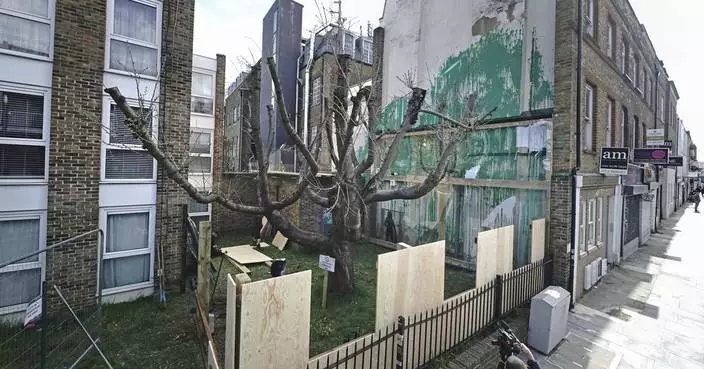Steelworker Ian Lewis is ramping up security to protect the stencilled artwork but has yet to receive any bids for it.
The owner of a garage used by Banksy as a canvas for his latest artwork is paying for a security firm to protect it from vandals.
Ian Lewis, 55, has also accepted an offer from a fan for the mural to be covered by a perspex screen while he decides what to do with the street artist’s latest work.
Mr Lewis, a steelworker at Port Talbot’s Tata Steel plant, said he has not slept properly since the artwork – which shows a child playing in the falling ash and smoke from a fire – appeared on his hand-built garage.
On Thursday he said he was paying out of his own pocket for a security team to guard the Banksy work after admitting he was struggling with the attention it has been receiving.
Mr Lewis said: “It started off as fun, but now it’s gone to stress. It’s down to not sleeping, but now I’ve got the security there it’s taken that weight off me. They will stay there indefinitely now I think.
“I’ve also got a guy who’s going to put a perspex screen around it later today. He was there taking photos and told me he’s a big fan.
“I’ve never experienced anything like this, to be honest with you. My phone is ringing, on my house phone there’s 1,000 messages on it. I’ve been down the chemist for 10 minutes and everyone’s talking to me.
“I’ve gone from an everyday steelworker to a face in the press.”
The father-of-one said he has not decided what to do with the artwork, and denied receiving any offers to sell it.
He said: “Nobody’d got in touch with me, there’s these rumours going around I’m having big offers, but nobody’s offered me anything.
“I’m really just rolling with it at the moment and I don’t know where it’s going.
“I have got someone who’s come on board and given me a bit of advice. I’m trying to get my head around it. All I’m saying is I’m not going to rush into anything.”
Banksy claimed responsibility for the new artwork on his website and Instagram account on Wednesday after it appeared on the side of Mr Lewis’s garage on Tuesday morning.
The work is Banksy’s first in Wales and is believed to be a comment on the town’s industrial heritage and pollution linked to its famous steel plant.
Neath Port Talbot County Borough Council erected metal fencing around the garage wall on Wednesday, and was consulting other councils who have experience of dealing with Banksy artworks.
VENICE, Italy (AP) — A pair of nude feet — dirty, wounded and vulnerable — are painted on the façade of the Venice women’s prison chapel. It's the work of Italian artist Maurizio Cattelan and part of the Vatican’s pavilion at the Venice Biennale contemporary art show in an innovative collaboration between inmates and artists.
That Cattelan is the lead artist is striking, given that his provocative life-size wax statue of Pope John Paul II lying on his side, crushed by a massive meteorite, shocked Catholics when it was displayed at the 2001 Biennale. The new work, titled “Father,” is considered a thematic counterpoint to a performance piece he produced for the 1999 Biennale titled “Mother,” during which a religious ascetic was buried under sand, with only his hands clasped in prayer showing.
The Vatican’s culture minister, Cardinal Jose Tolentino de Mendonca, praised the work, which he said recalled the naked, dirty feet of Caravaggio’s saints, while also being highly symbolic of the journey behind the Holy See’s pavilion, showing “the desire to dirty one’s feet, to show that whoever has feet has a carnality.’’
Tolentino de Mendonca, prefect of the Dicastery for Culture and Education, said the Vatican did not want to shy away from artists or works that might be considered iconoclastic, or critical of institutions like the Catholic church.
“Pope Francis calls us to dialogue. Dialogue is not just with the people who are mirrors of ourselves,’’ he told The Associated Press. “We did not seek out easy artists. We sought real artists. Cattelan’s work is very interesting under a religious point of view, because there is something iconoclastic in his work, but also in the mystic there is something that can be called iconoclastic, in the sense of deconstructing the religious representation.’’
Pope Francis, who met with over 200 artists in the Sistine Chapel last year, will see for himself when he visits the pavilion April 28, meeting inmates and artists, and according to the prefect not just the ones participating in the pavilion.
Cattelan, who wandered by the work as preview tours continued this week, declined to discuss his contribution but said the feet would be reproduced on a church in Rome in the future.
Cattelan’s artwork can be viewed by anyone who makes the trek to the Giudecca island prison. Those who want to see the other works will be guided through the prison on four daily tours by inmates, leaving bags and mobile phones in lockup.
Closed Wednesdays, a maximum 600 people will view the pavilion each week during the Biennale's run from April 20-Nov. 26. The 60th International Art Exhibition comprises 88 national pavilion s along with a main show curated this year by Brazilian Adriano Pedrosa.
On a recent tour, three inmates wearing elegant black and white smocks made by prison seamstresses guided journalists through an installation by Simone Fattal who transformed inmates’ poems into small ceramic plaques hung along a brick alleyway.
The tour continued to a prison coffee bar decorated with posters by onetime Catholic nun Corita Kent and into a gallery where Claire Tabouret has painted images from photographs provided by inmates of themselves and loved ones.
The conceptual artistic duo known as Claire Fontaine provided a neon eye with a slash through it for an outdoor corridor, and another neon sign that reads: “Siamo con voi nella notte," (“We are with all of you in the night”).
That sign, in a courtyard where the inmates can gather during the day, provides a reassuring blue glow into the overlooking cells where they sleep.
“When we read this writing, it gives us encouragement, because there is someone with us day and night,” said one inmate named Manuela, who like the others declined to give their full names. “At night, we see the blue light, so we know it is there.”
The tour ended with a 15-minute film by Italian director Marco Perego starring his wife, actor Zoe Saldana, both of whom tagged along. Saldana plays an inmate in her final hours before release, and she took inspiration from the inmates who appeared in the film. To protect their privacy, the film can only be seen within the prison walls.
“What we wanted to provide for them was just a little bit of visibility, and to add a little bit of levity through art, which is exactly what we accomplished,’’ Saldana said.
Their desire for visibility was expressed in letters that the women gave the couple each night after filming, and through requests to pose with the couple for photos, which Saldana said they printed as keepsakes for the women.
Chiara Parisi, the director of the Centre Pompidou-Metz and one of the curators, said the project created a unique synergy between artists and inmates that opened lines of empathy. After the pavilion closes at the end of the Biennale, she said a coat of paint would likely cover Cattelan’s work, while the other pieces will find other venues; she said she hoped its larger legacy would be other similar initiatives.
“Through this pavilion, we hope to truly demonstrate the desire for freedom, the work to get out, to be free is something essential," Parisi told AP. “Detention is a moment in their lives, and the artists say so, they themselves say so. Just a moment, a photograph, that should not impact what comes after, should not prejudice their future lives.”
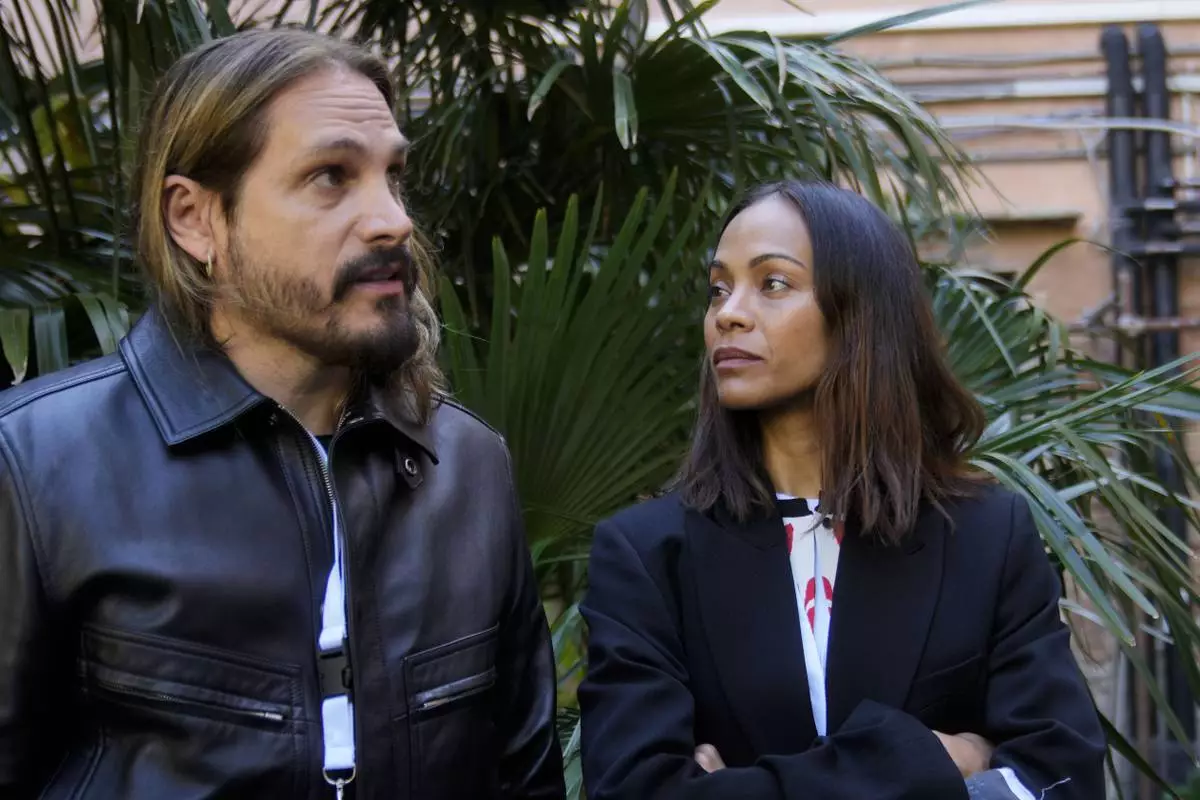
U.S. actress Zoe Saldana looks to her husband and movie director Marco Perego during press preview inside the women's prison at the Giudecca island during the 60th Biennale of Arts exhibition in Venice, Italy, Wednesday, April 17, 2024. A pair of nude feet dirty, wounded and vulnerable are painted on the façade of the Venice women's prison chapel, the work of Italian artist Maurizio Cattelan and part of the Vatican's pavilion at the Venice Biennale in an innovative collaboration between inmates and artists. (AP Photo/Luca Bruno)
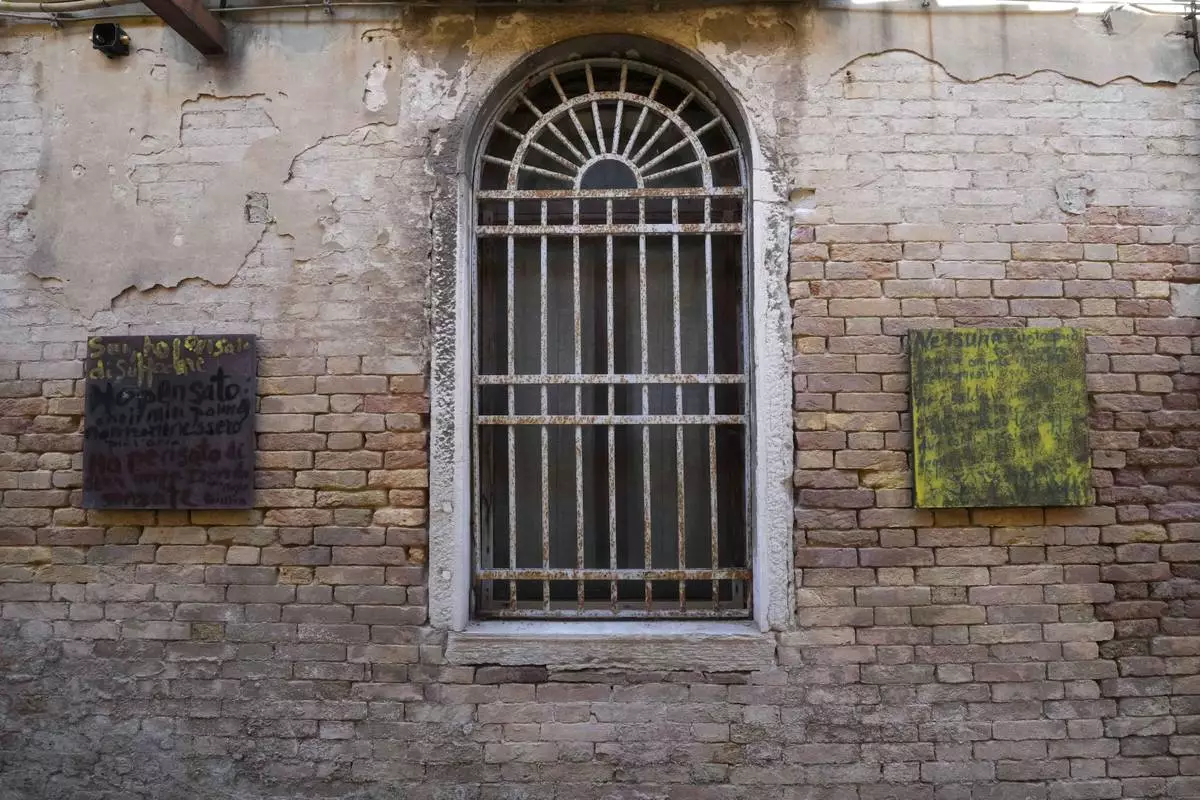
An installation by artist Simone Fattal is displayed inside the women's prison at the Giudecca island during the 60th Biennale of Arts exhibition in Venice, Italy, Wednesday, April 17, 2024. A pair of nude feet dirty, wounded and vulnerable are painted on the façade of the Venice women's prison chapel, the work of Italian artist Maurizio Cattelan and part of the Vatican's pavilion at the Venice Biennale in an innovative collaboration between inmates and artists. (AP Photo/Luca Bruno)
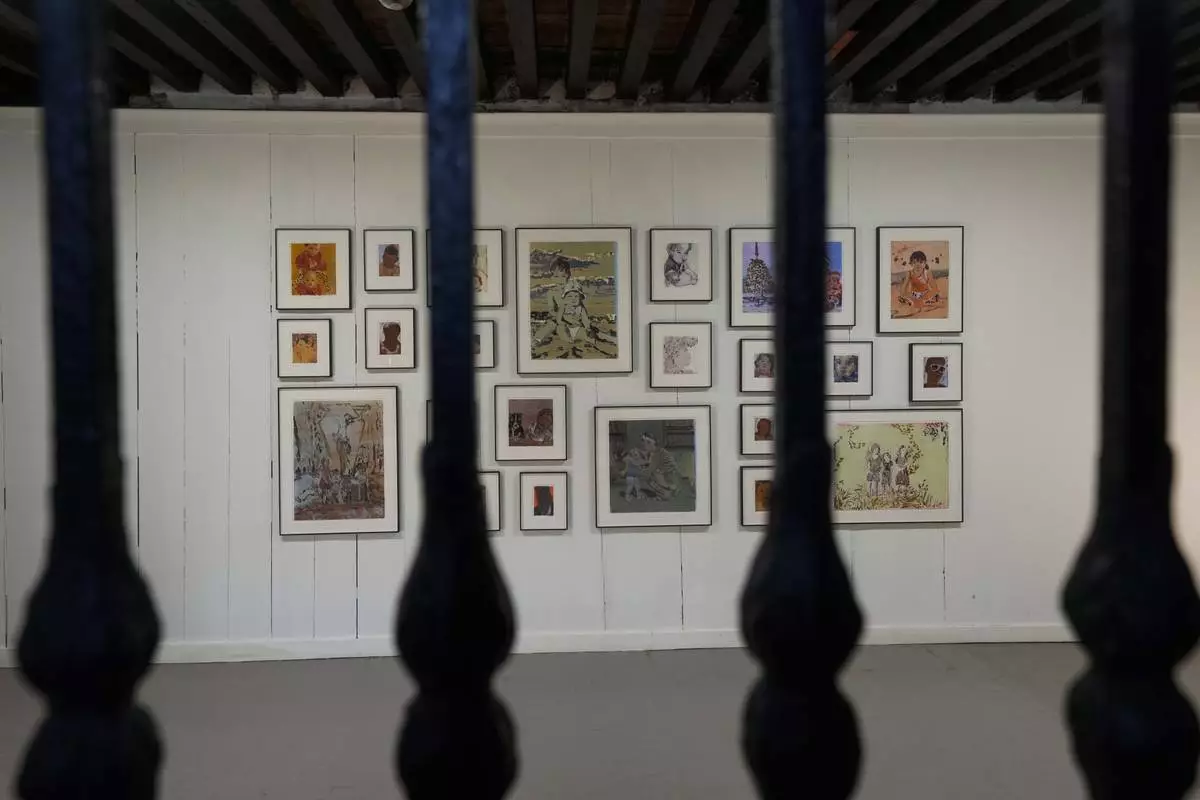
An installation by artist Claire Tabouret is displayed inside the women's prison of he Giudecca island during the 60th Biennale of Arts exhibition in Venice, Italy, Wednesday, April 17, 2024. A pair of nude feet dirty, wounded and vulnerable are painted on the façade of the Venice women's prison chapel, the work of Italian artist Maurizio Cattelan and part of the Vatican's pavilion at the Venice Biennale in an innovative collaboration between inmates and artists. (AP Photo/Luca Bruno)
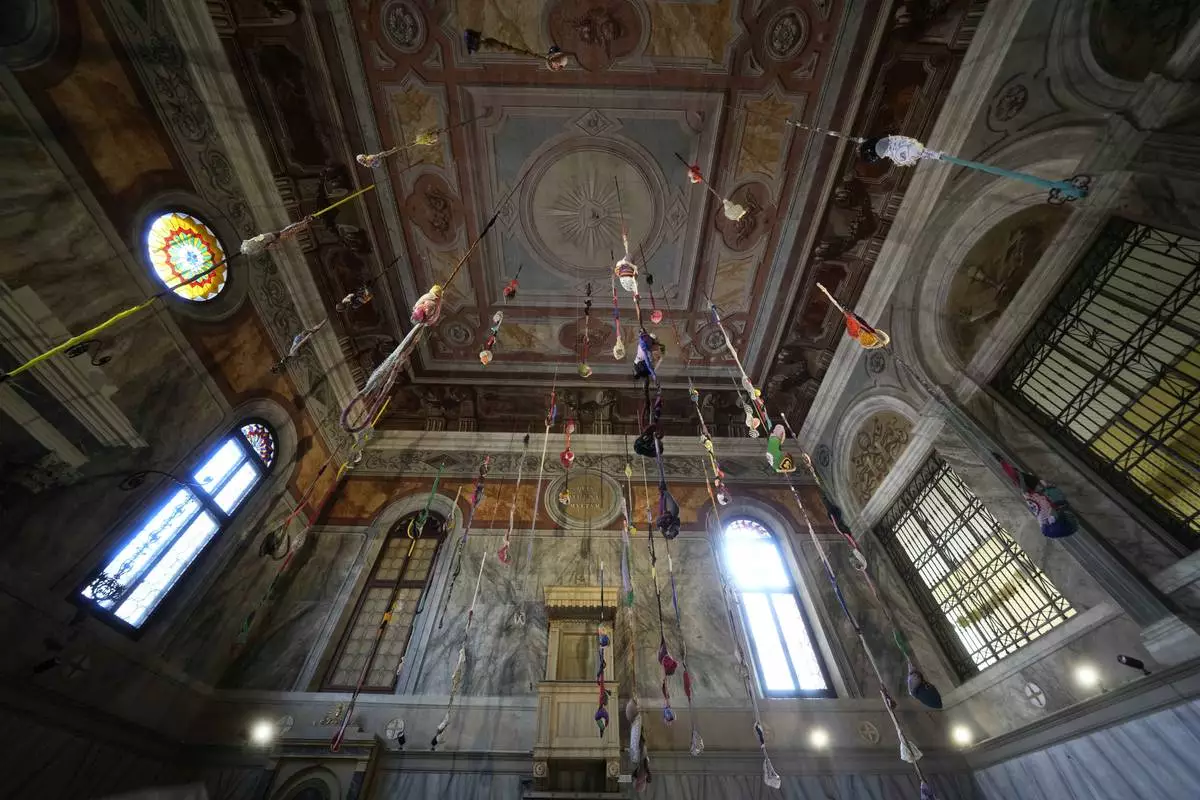
An installation by artist Sonia Gomes is displayed inside the church Santa Maria Maddalena Convertita at the women's prison of he Giudecca island during the 60th Biennale of Arts exhibition in Venice, Italy, Wednesday, April 17, 2024. A pair of nude feet dirty, wounded and vulnerable are painted on the façade of the Venice women's prison chapel, the work of Italian artist Maurizio Cattelan and part of the Vatican's pavilion at the Venice Biennale in an innovative collaboration between inmates and artists. (AP Photo/Luca Bruno)
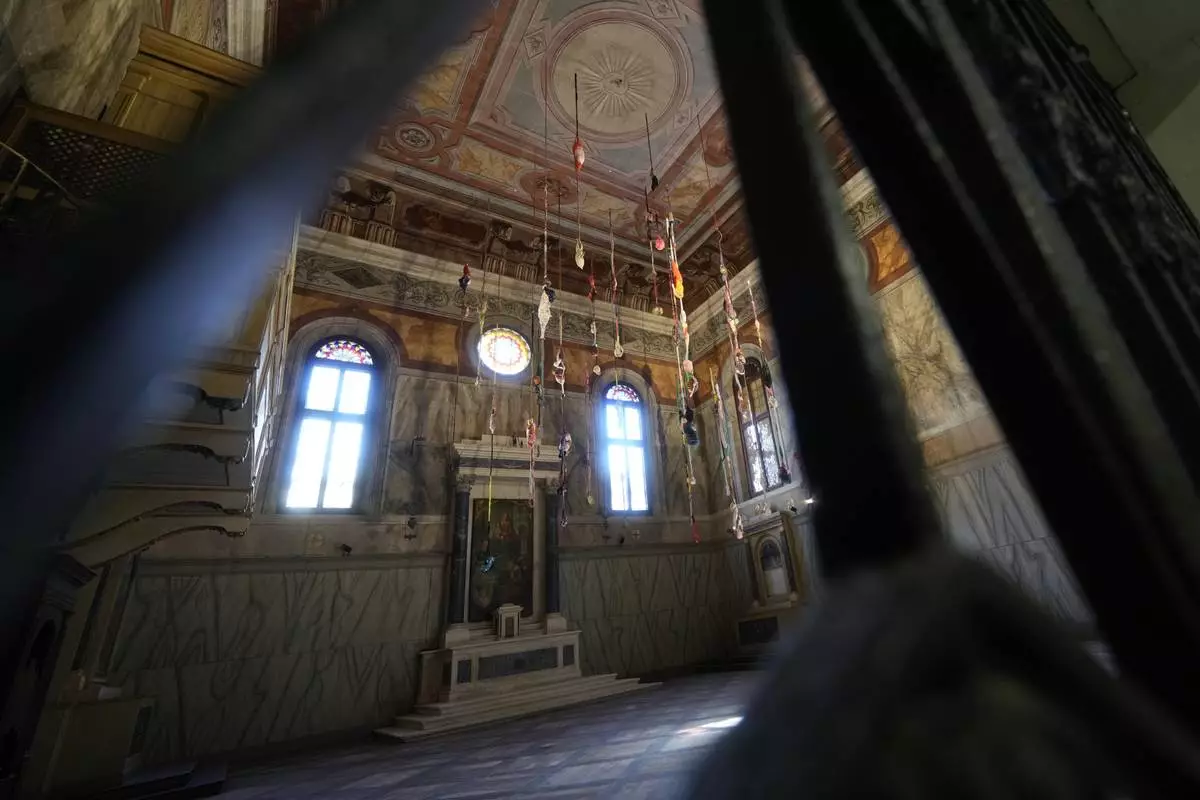
An installation by artist Sonia Gomes is displayed inside the church Santa Maria Maddalena Convertita at the women's prison of he Giudecca island during the 60th Biennale of Arts exhibition in Venice, Italy, Wednesday, April 17, 2024. A pair of nude feet dirty, wounded and vulnerable are painted on the façade of the Venice women's prison chapel, the work of Italian artist Maurizio Cattelan and part of the Vatican's pavilion at the Venice Biennale in an innovative collaboration between inmates and artists. (AP Photo/Luca Bruno)
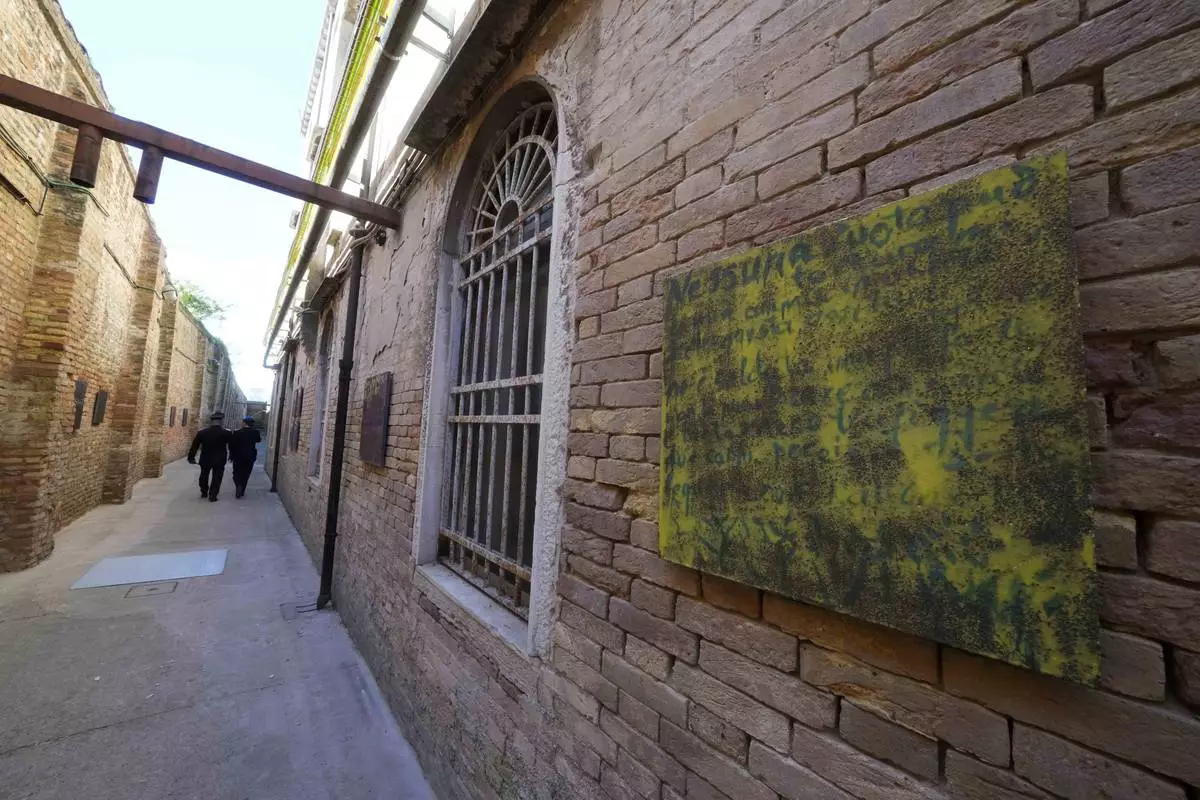
An installation by artist Simone Fattal is displayed inside the women's prison at the Giudecca island during the 60th Biennale of Arts exhibition in Venice, Italy, Wednesday, April 17, 2024. A pair of nude feet dirty, wounded and vulnerable are painted on the façade of the Venice women's prison chapel, the work of Italian artist Maurizio Cattelan and part of the Vatican's pavilion at the Venice Biennale in an innovative collaboration between inmates and artists. (AP Photo/Luca Bruno)
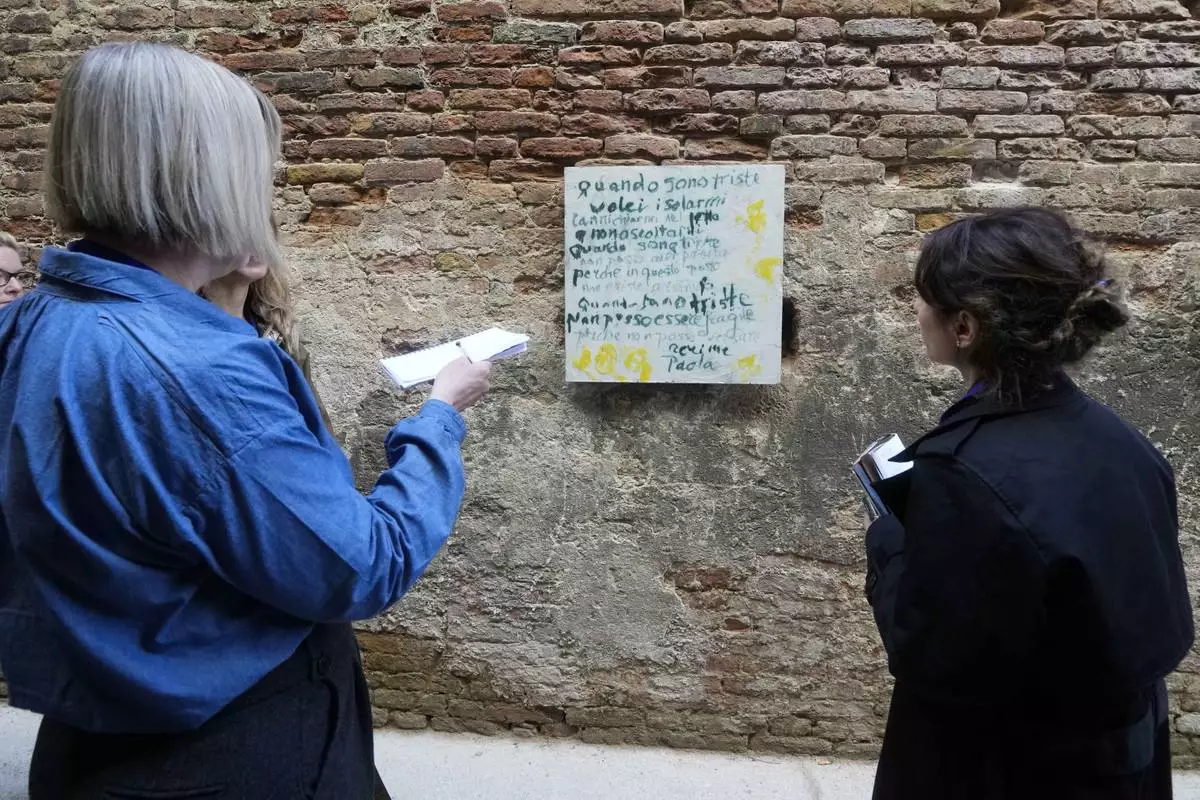
Reporters watches an installation by artist Corita Kent displayed inside the women's prison at the Giudecca island during the 60th Biennale of Arts exhibition in Venice, Italy, Wednesday, April 17, 2024. A pair of nude feet dirty, wounded and vulnerable are painted on the façade of the Venice women's prison chapel, the work of Italian artist Maurizio Cattelan and part of the Vatican's pavilion at the Venice Biennale in an innovative collaboration between inmates and artists. (AP Photo/Luca Bruno)
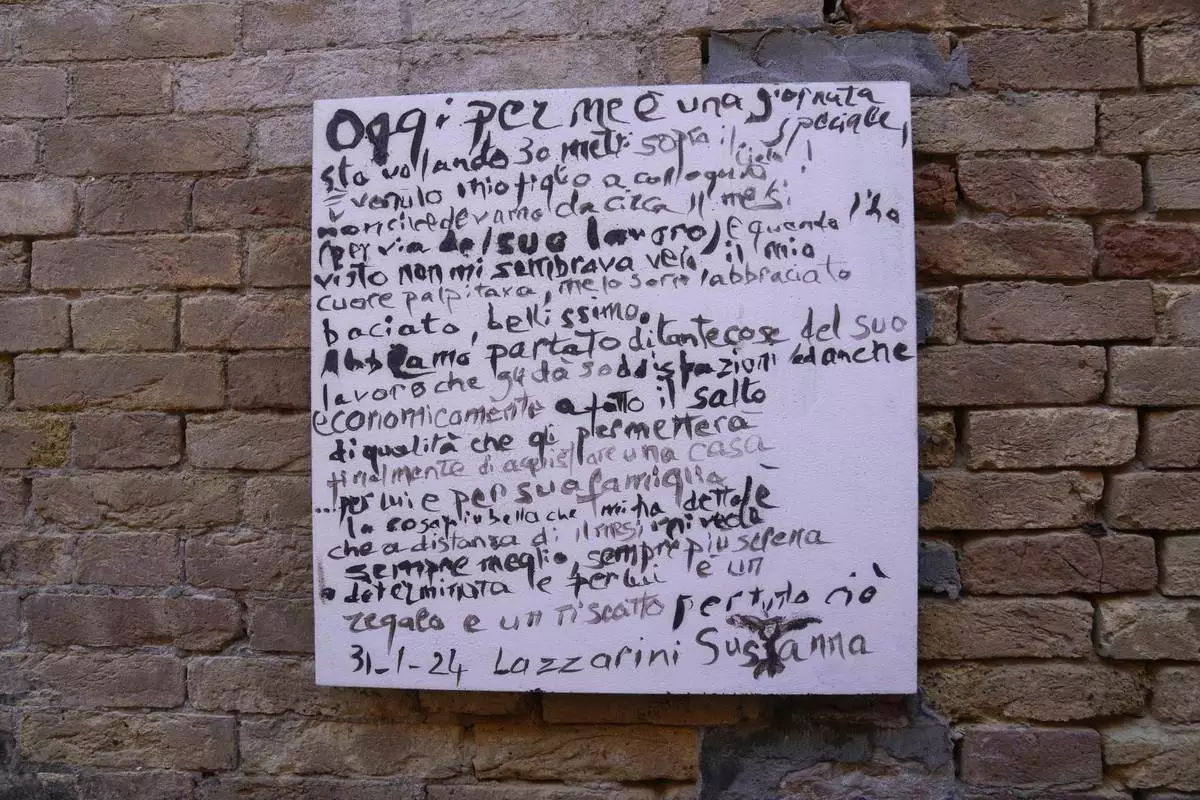
An installation by artist Simone Fattal is displayed inside the women's prison at the Giudecca island during the 60th Biennale of Arts exhibition in Venice, Italy, Wednesday, April 17, 2024. A pair of nude feet dirty, wounded and vulnerable are painted on the façade of the Venice women's prison chapel, the work of Italian artist Maurizio Cattelan and part of the Vatican's pavilion at the Venice Biennale in an innovative collaboration between inmates and artists. (AP Photo/Luca Bruno)
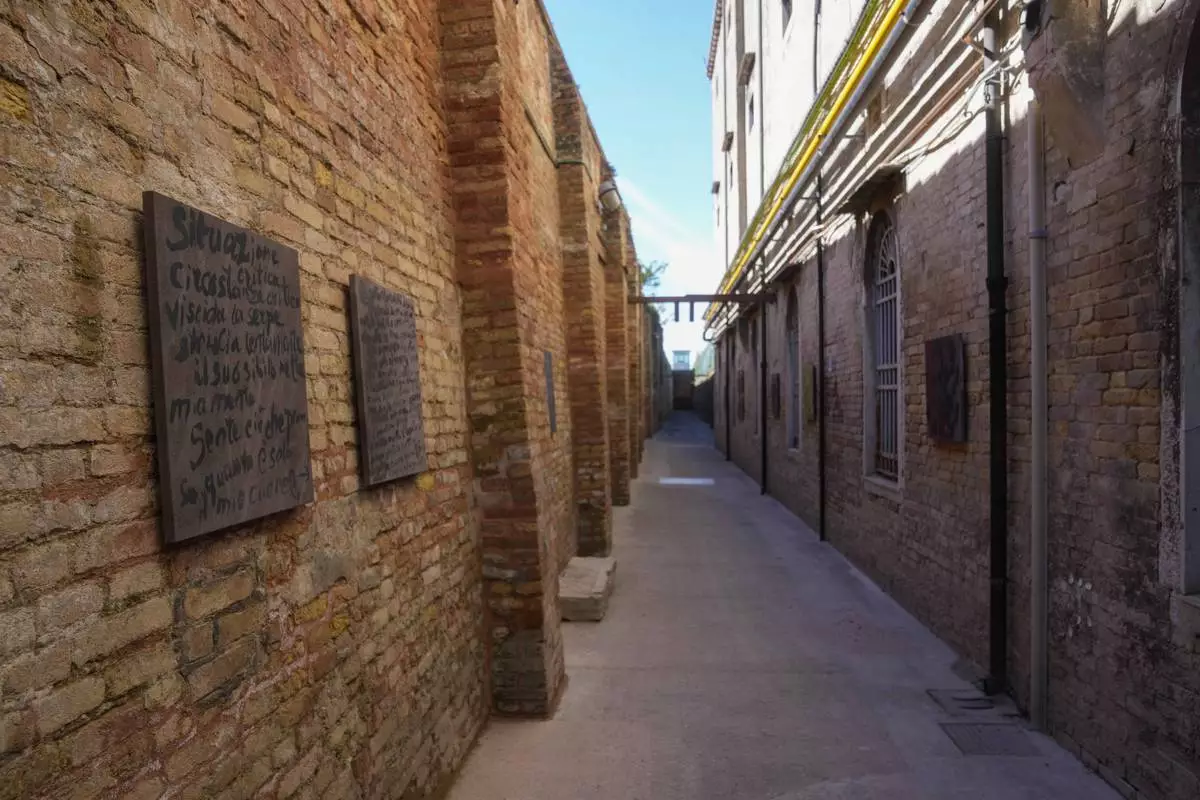
An installation by artist Simone Fattal is displayed inside the women's prison at the Giudecca island during the 60th Biennale of Arts exhibition in Venice, Italy, Wednesday, April 17, 2024. A pair of nude feet dirty, wounded and vulnerable are painted on the façade of the Venice women's prison chapel, the work of Italian artist Maurizio Cattelan and part of the Vatican's pavilion at the Venice Biennale in an innovative collaboration between inmates and artists. (AP Photo/Luca Bruno)
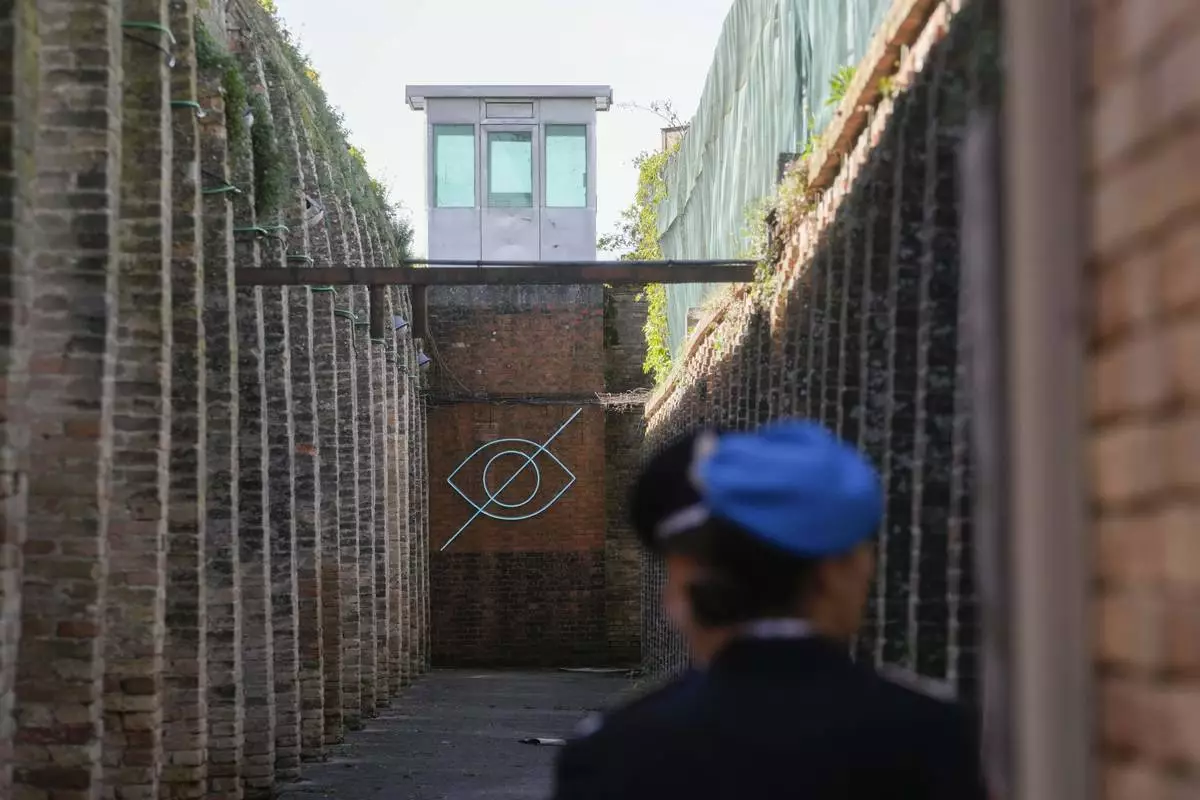
The installation 'White Sight' by artist Claire Fontaine is displayed inside the women's prison at the Giudecca island during the 60th Biennale of Arts exhibition in Venice, Italy, Wednesday, April 17, 2024. A pair of nude feet dirty, wounded and vulnerable are painted on the façade of the Venice women's prison chapel, the work of Italian artist Maurizio Cattelan and part of the Vatican's pavilion at the Venice Biennale in an innovative collaboration between inmates and artists. (AP Photo/Luca Bruno)
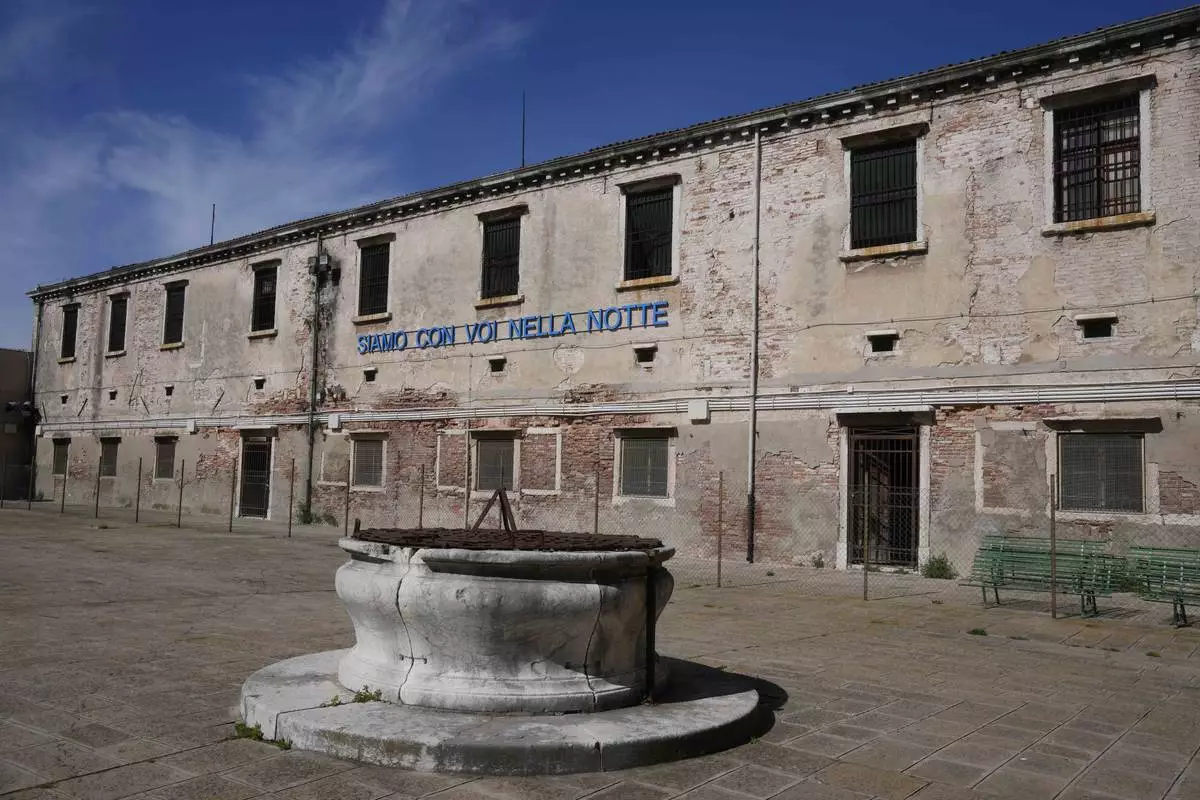
The installation 'Siamo con voi nella notte' (We are with you overnight) by artist Claire Fontaine is displayed inside the women's prison at the Giudecca island during the 60th Biennale of Arts exhibition in Venice, Italy, Wednesday, April 17, 2024. A pair of nude feet dirty, wounded and vulnerable are painted on the façade of the Venice women's prison chapel, the work of Italian artist Maurizio Cattelan and part of the Vatican's pavilion at the Venice Biennale in an innovative collaboration between inmates and artists. (AP Photo/Luca Bruno)
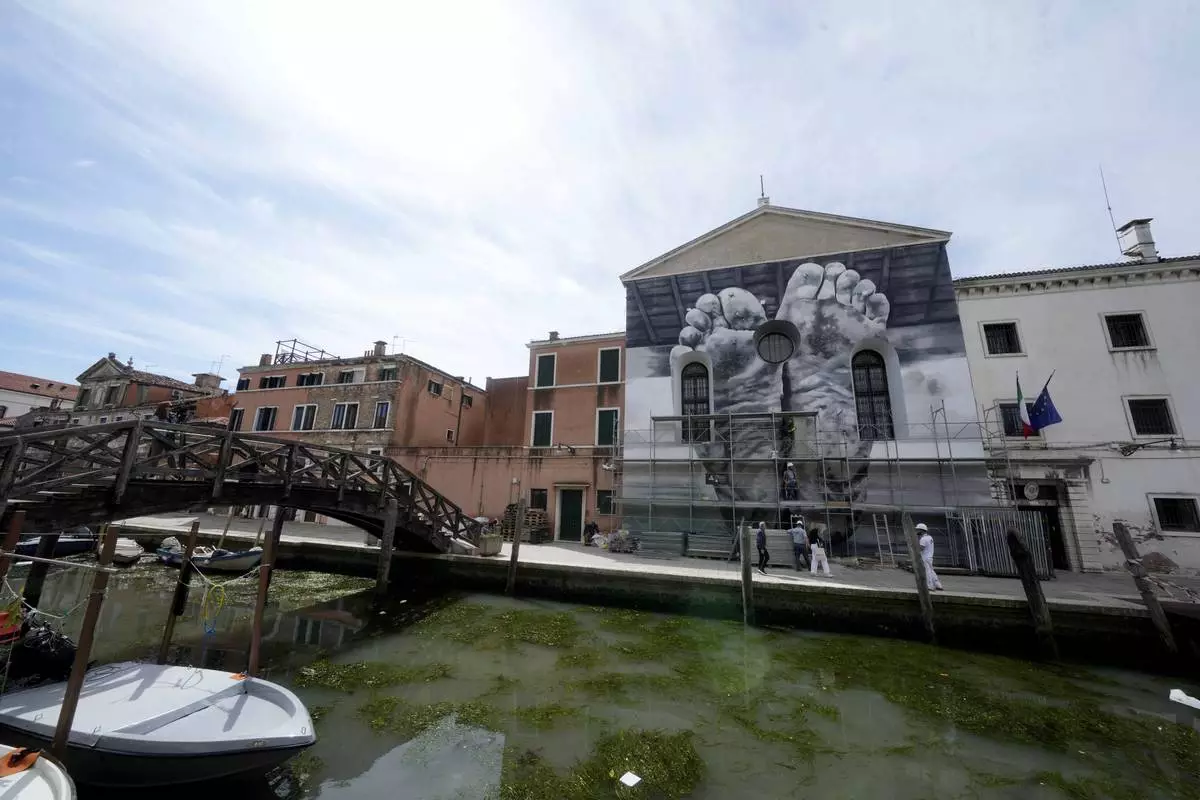
The installation '"I piedi, insieme al cuore, portano la stanchezza e il peso della vita" ('The feet, together with the heart, carry the tiredness and weight of life') by Italian artist Maurizio Catalan is displayed on the facade of the church next to the women's prison at the Giudecca island during the 60th Biennale of Arts exhibition in Venice, Italy, Wednesday, April 17, 2024. A pair of nude feet dirty, wounded and vulnerable are painted on the façade of the Venice women's prison chapel, the work of Italian artist Maurizio Cattelan and part of the Vatican's pavilion at the Venice Biennale in an innovative collaboration between inmates and artists. (AP Photo/Luca Bruno)

















